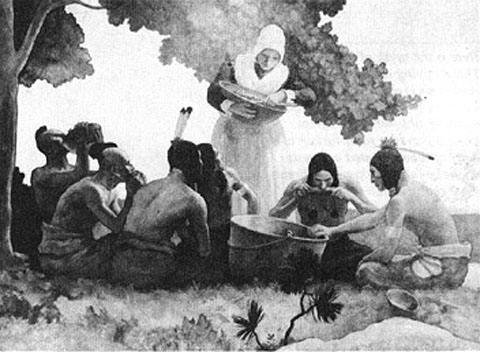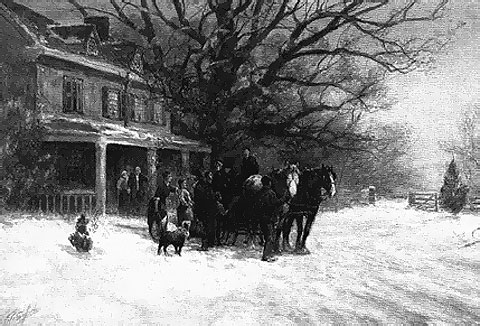SUBJECT: THANKSGIVING
SOURCE: JUAN WILSON juanwilson@mac.com
POSTED: 22 NOVEMBER 2007 - 8:30am HST
Thanksgiving past and far away

image above: painting by N.C. Wyeth: "The First Thanksgiving"
| Thanksgiving Feasts by Linda Pascatore on Thanksgiving 1993 in The Gobbler Thanksgiving is a holiday when families gather, give thanks, and celebrate the harvest with a special meal. As holidays go, it is quite calm and simple; a family day. It doesn't have the hype, gimmicks and materialism that surround some other celebrations. Often relatives travel some distance to "gather in" for Thanksgiving. There is a frenzy of baking and wonderful smells for at least a day before carving the turkey. On Thanksgiving morn, anticipation is excruciating and delightful as the turkey cooks slowly in the oven. Traditionally, some of the trappings include cranberry sauce, stuffing, mashed potatoes and gravy, cornmeal bread, squash or yams, apple cider, and of course the desserts--pumpkin, apple, and mince pies with plenty of whipped cream. But before the feast begins, families take time to give thanks--for their loved ones, their health, their good fortunes and for the food that sustains them. Thanksgiving has its origins in many traditions. People throughout history have had harvest celebrations, where they gave thanks for the fruit of their labors which would carry them through the coming winter. The Romans honored the goddess of the harvest, Ceres, with parades, dancing, sports and feasting. The ancient Jews celebrated the Feast of Booths, named for the structures built from branches where they stored their harvest. In China there was "Hhung-Ch'iu", or Birthday of the Moon, held during the time of the large, bright harvest moon. At this time of year, farmers used the light of the moon to extend the working day and bring in the crops. After the harvest on the night of the festival, the Chinese people would put round fruits or moon cakes on altars in their courtyards, have a ceremony, and celebrate at midnight with a moonlight feast outdoors. The English celebrated Harvest Home. The reaper who cut the last sheaf of wheat was named Lord of the Harvest. He and his wife or sweetheart were carried home on top of the last load of grain. The other field hands and villagers would walk beside the wagon carrying flowers. When they arrived home, the master and mistress of the estate would have a feast ready for them in the barn. Roast beef and suet pudding were often served. This tradition was part of the English heritage of the Pilgrims and Puritans in America. Their religions forbade most English holidays, but the urge to celebrate the harvest was deeply ingrained in them. Any American school child will tell you that the first Thanksgiving Day was the feast of the Pilgrims and the Indians. In December, 1620, the Pilgrims landed in Plymouth, Massachusetts. They were ill prepared for the winter, with most of the ship's stores used up. Only 55 of the original 102 immigrants survived that first winter. The next spring, they were befriended by a Native American Indian called Squanto, who spoke English. He introduced them to the local tribe, the Wampanoag, and their sachem (chief), Massasoit. This tribe welcomed the Pilgrims. Without the help of the Indians, they would never have made it through the following winter. Squanto taught the Pilgrims about the corn, beans, and squash which were the staples of the native diet. The newcomers learned that corn was to be planted when the bud of the white oak tree grew to the size of a mouse's ear. They were told to place three herrings in each corn hill to fertilize it, and to guard the plants from wolves and dogs that might dig up the fish. Squanto showed the Pilgrims where to fish and gather shellfish and how to make chowder. He told them which wild plants were useful for food and medicine. He showed them how to make corn meal and maple syrup. Because of the Indian's assistance, the new settlers had a good harvest in the autumn of 1621, which would see them through the next winter. Governor Bradford proclaimed a day of thanksgiving and celebration of the harvest, and invited the neighboring Indians to join in the feast. Edward Winslow's first hand account of the feast survives: "Our harvest being gotten in, our Governour sent foure men fowling, so that we might after a more special manner rejoyce together, after we had gathered the fruit of our labours; they foure in one day killed as much fowle, as with a little helpe beside, served the Company almost a weeke, at which time amongst other Recreations we excercised our Armes, many of the Indians coming amounst us, and amongst the rest their greatest King Massasoyt, with some ninetie men, whom for three days we entertained and feasted, and they went out and killed five Deere which they brought to the Plantacion and bestowed on our Governour, and upon the Captaine, and others." The gaming expedition might have brought home partridges, ducks, geese, and turkeys. We have no way of knowing whether turkey was part of the feast. We do know that venison was brought by the Indians. The rest of the dinner was very different than what we think of as traditional today. The Pilgrims had no flour left, and no milk, butter, or cheese was available since cows were not aboard the Mayflower. They had plenty of squash and pumpkins, which were probably just boiled. Corn could have been roasted in the fire, or ground into cornmeal and used to make "hasty pudding" or fried corn cakes. Wild berries, including cranberries, would have been sweetened with honey or maple syrup to make a sauce for the meat. Nuts and dried berries were probably served as well. They might have enjoyed a salad of watercress and leeks. The meal would have definitely included some of the plentiful harvest from the sea: fish, lobsters, clams, and oysters. The Indians might have shared wine made from wild grapes. A treaty was eventually signed which kept the peace for the next fifty years between the Pilgrims and the Wampanoag. It is a shame that the peaceful coexistence between the Native Americans and the settlers could not last. The tremendous pressure of the growing European population eventually resulted in Indians being driven from their ancestral lands. Treaties were made and broken time and again, with relocations and more land lost each time. One reason the Native Americans fared so badly with treaties was that they had no concept of land ownership in the European sense of the word. They believed that they belonged to the earth, which provided for all its creatures if treated with respect and care. No one could own exclusive rights to the resources given by the Great Spirit. When they signed treaties deeding the white men land, they envisioned sharing the area with them. Over a period of several hundred years, the settlers were responsible for the virtual genocide of the Native American people and their culture. Although the celebration of the Pilgrims and the Indians in the fall of 1621 is generally considered the first Thanksgiving, it was not an annual celebration until later. At first, there were occasional local Thanksgiving ceremonies for certain events, such as an especially good harvest, a long awaited ship's arrival, a victory during war, or a peace treaty. Around 1640, Puritans in several towns in Connecticut began annual proclamations of Thanksgiving around harvest time. This practice spread through New England, and then to the rest of the country. In 1863, President Lincoln made the last Thursday in November a national holiday, Thanksgiving Day. The earliest Thanksgiving celebrations, unlike our holiday, were at the actual time of harvest. That would probably have been in late September or early October in this climate, not at the end of November when Thanksgiving was set. By late autumn, fresh produce was gone and people were beginning to take stored food from root cellars and pantries. It was also hunting season, when game was plentiful and meat was being dried or canned. A good store of food was essential for survival through the winter. Thanksgiving was probably one of the last times they could afford to feast. After this, the stores of food would be carefully rationed until spring. It was a time of gratitude for the last season and hope for the coming one. Today, Thanksgiving day has lost some of its meaning. Most people buy all the fixings for their Thanksgiving dinner from the supermarket. Some city people are barely aware of the harvest or what it means. Some of the more spiritual aspects have also been eroded, and for some, Thanksgiving is nothing but a big meal wedged between football games. Fortunately, most of us here in this rural area still garden, farm, and hunt. We may grow some of the food we eat; or raise or hunt some of the meat served on Thanksgiving. Even if we don't participate directly in these activities, we are much more connected to the seasons than urban or suburban dwellers. We see nature and its changes daily; out our windows, on a walk, or driving past the fields on our way to work. We can still appreciate a good harvest and can see how crucial the harvest was in order to make it through the winter. As we gather with family or friends this Thanksgiving, we have much to be thankful and hopeful for. Sources: Thanksgiving: An American Holiday, An American History, by Diana Karter Appelbaum Thanksgiving Day, by Robert Merrill Bartlett The Plymouth Thanksgiving, by Leonard Weisgard |

image above: Detail of the "Candyland" board game
Grandma's Farm
|
Pau